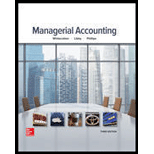
Managerial Accounting
3rd Edition
ISBN: 9780077826482
Author: Stacey M Whitecotton Associate Professor, Robert Libby, Fred Phillips Associate Professor
Publisher: McGraw-Hill Education
expand_more
expand_more
format_list_bulleted
Question
Chapter 13, Problem 5E
To determine
Introduction:
Time interest earned ratio measure the ability of the company to meet its obligations of debt. It is the ratio of operating income to interest expense.
To calculate:
The time interest earned for 2012 and 2013 and comment on the same.
Expert Solution & Answer
Want to see the full answer?
Check out a sample textbook solution
Students have asked these similar questions
Westake Advisors is a consulting firm. The firm expects to have $75,000 in indirect costs during the year and bill customers for 10,000 hours. The cost of direct labor is $95 per hour. Calculate the predetermined overhead allocation rate for Westake Advisors
Andy Manufacturing produces plastic and metal kitchen utensils. In preparing the current budget, Andy's management estimated a total of $380,000 in manufacturing overhead costs and 19,000 direct labor hours for the coming year. In December, Andy's accountants reported actual manufacturing overhead incurred of $93,000 and 18,200 direct labor hours used during the year. Andy applies overhead based on direct labor hours. Required: What was Andy's predetermined overhead rate for the year? How much manufacturing overhead did Andy apply during the year?
Please provide the solution to this general accounting question with accurate financial calculations.
Chapter 13 Solutions
Managerial Accounting
Ch. 13 - Prob. 1QCh. 13 - Prob. 2QCh. 13 - What is ratio analysis? Why is it useful?
Ch. 13 - What benchmarks are commonly used for interpreting...Ch. 13 - Prob. 5QCh. 13 - Why are some analyses called horizontal and others...Ch. 13 - Slow Cellar’s current ratio increased from 1.2 to...Ch. 13 - From last year to this year. Colossal Company’s...Ch. 13 - From last year to this year, Berry Barn reported...Ch. 13 - Prob. 10Q
Ch. 13 - Prob. 1MCCh. 13 - Prob. 2MCCh. 13 - Prob. 3MCCh. 13 - Prob. 4MCCh. 13 - Prob. 5MCCh. 13 - Prob. 6MCCh. 13 - Prob. 7MCCh. 13 - Prob. 8MCCh. 13 - Prob. 9MCCh. 13 - Prob. 1MECh. 13 - Prob. 2MECh. 13 - Prob. 3MECh. 13 - Prob. 4MECh. 13 - Prob. 5MECh. 13 - Prob. 6MECh. 13 - Prob. 7MECh. 13 - Prob. 8MECh. 13 - Prob. 9MECh. 13 - Prob. 10MECh. 13 - Prob. 11MECh. 13 - Prob. 12MECh. 13 - Prob. 13MECh. 13 - Prob. 14MECh. 13 - Prob. 1ECh. 13 - Prob. 2ECh. 13 - Prob. 3ECh. 13 - Prob. 4ECh. 13 - Prob. 5ECh. 13 - Prob. 6ECh. 13 - Prob. 7ECh. 13 - Computing and Interpreting Liquidity Ratios...Ch. 13 - Prob. 9ECh. 13 - Prob. 10ECh. 13 - Prob. 11ECh. 13 - Prob. 12ECh. 13 - Prob. 13ECh. 13 - Analyzing the Impact of Selected Transactions on...Ch. 13 - Prob. 15ECh. 13 - Prob. 1.1GAPCh. 13 - Prob. 1.2GAPCh. 13 - Prob. 2.1GAPCh. 13 - Prob. 2.2GAPCh. 13 - Prob. 2.3GAPCh. 13 - Prob. 2.4GAPCh. 13 - Prob. 2.5GAPCh. 13 - Prob. 2.6GAPCh. 13 - Prob. 2.7GAPCh. 13 - Prob. 2.8GAPCh. 13 - Prob. 3.1GAPCh. 13 - Prob. 3.2GAPCh. 13 - Prob. 3.3GAPCh. 13 - Prob. 4.1GAPCh. 13 - Prob. 4.2GAPCh. 13 - Prob. 4.3GAPCh. 13 - Prob. 5.1GAPCh. 13 - Prob. 5.2GAPCh. 13 - Prob. 5.3GAPCh. 13 - Prob. 5.4GAPCh. 13 - Prob. 6.1GAPCh. 13 - Prob. 6.2GAPCh. 13 - Prob. 7GAPCh. 13 - Prob. 1.1GBPCh. 13 - Prob. 1.2GBPCh. 13 - Prob. 2.1GBPCh. 13 - Prob. 2.2GBPCh. 13 - Prob. 2.3GBPCh. 13 - Prob. 2.4GBPCh. 13 - Prob. 2.5GBPCh. 13 - Prob. 2.6GBPCh. 13 - Prob. 2.7GBPCh. 13 - Prob. 2.8GBPCh. 13 - Prob. 3.1GBPCh. 13 - Prob. 3.2GBPCh. 13 - Prob. 3.3GBPCh. 13 - Prob. 4.1GBPCh. 13 - Prob. 4.2GBPCh. 13 - Prob. 4.3GBPCh. 13 - Prob. 5.1GBPCh. 13 - Prob. 5.2GBPCh. 13 - Prob. 5.3GBPCh. 13 - Prob. 5.4GBPCh. 13 - Prob. 6.1GBPCh. 13 - Prob. 6.2GBPCh. 13 - Prob. 7GBP
Knowledge Booster
Learn more about
Need a deep-dive on the concept behind this application? Look no further. Learn more about this topic, accounting and related others by exploring similar questions and additional content below.Similar questions
- I need help with this financial accounting question using standard accounting techniques.arrow_forwardI need help solving this general accounting question with the proper methodology.arrow_forwardPlease help me solve this general accounting question using the right accounting principles.arrow_forward
- Can you solve this general accounting question with the appropriate accounting analysis techniques?arrow_forwardCan you provide a detailed solution to this financial accounting problem using proper principles?arrow_forwardPlease provide the accurate answer to this financial accounting problem using appropriate methods.arrow_forward
- Omega Retail had accounts receivable of $450,000 at year-end. Based on historical data, the company estimates that 3% of accounts receivable will be uncollectible. The Allowance for Doubtful Accounts had a credit balance of $2,800 before adjustment. Calculate the required bad debt expense for the year.arrow_forwardCan you solve this general accounting problem with appropriate steps and explanations?arrow_forwardI am trying to find the accurate solution to this general accounting problem with the correct explanation.arrow_forward
arrow_back_ios
SEE MORE QUESTIONS
arrow_forward_ios
Recommended textbooks for you

 Intermediate Financial Management (MindTap Course...FinanceISBN:9781337395083Author:Eugene F. Brigham, Phillip R. DavesPublisher:Cengage Learning
Intermediate Financial Management (MindTap Course...FinanceISBN:9781337395083Author:Eugene F. Brigham, Phillip R. DavesPublisher:Cengage Learning




Intermediate Financial Management (MindTap Course...
Finance
ISBN:9781337395083
Author:Eugene F. Brigham, Phillip R. Daves
Publisher:Cengage Learning

Financial ratio analysis; Author: The Finance Storyteller;https://www.youtube.com/watch?v=MTq7HuvoGck;License: Standard Youtube License